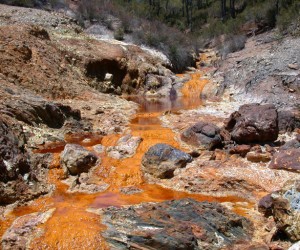The long-awaited acid mine drainage (AMD) long-term solution has be been launched, and Water and Sanitation Minister Nomvula Mokonyane promises it will improve the water supply to the nation’s economic hub.
Following the successful completion of the short-term solution, where the Trans-Caledon Tunnel Authority (TCTA) was mandated by government in 2011 -- through the Inter-Ministerial Committee (IMC) -- to provide a short-term solution to the AMD challenge in Gauteng. It will now be integrated into the long-term solution.
Launched on Wednesday at the AMD Central Basin, the planned intervention will turn the AMD problem into a long-term sustainable solution by producing fully treated water that will significantly increase water supply to the Vaal River System and defer the need for further costly augmentation beyond Phase 2 of the Lesotho Highlands Water Projects for at least 30 years.
AMD is the flow of polluted water from old mining areas. The water may contain high levels of salts, sulphate, iron, aluminium, toxic heavy metals and radioactive elements. This contaminated water can pollute soil and water supplies as it spreads underground and flows into streams and rivers.
Minister Mokonyane said the highlight of the long-term solution is that this polluted water will now become a commodity, as it will be treated and it will boost the water resources in the Vaal River System - a key driver for socio-economic development in the Gauteng region.
“This initiative of water reuse entrenches the principle enshrined in our sector policies and strategies,” Minister Mokonyane said.
She said she was confident the TCTA had the capacity to successfully execute the long-term solution, as it had the requisite experience in AMD emergency works projects.
TCTA will accelerate the implementation of the long-term project. It is expected to complete the Environmental Impact Assessment in June 2017. Construction of infrastructure to treat the polluted water is expected to commence in January 2018, with the project being commissioned in November 2019. It will start operating in February 2020.
Project funding
The Minister said the combined cost of the emergency works and long-term solution projects is estimated to range between R10 billion and R12 billion.
“The funding model is based on equitable allocation to us as government, the mining sector and water users,” said Minister Mokonyane.
She said the mining sector, as a contributor to AMD, should carry a share of the costs, although without unnecessary overburdening the sector and threatening jobs.
“In recognising the benefits to the country from mining, government has decided that the fiscus should shoulder some of the costs.
“With the support of National Treasury, we have decided to cap the contributions of the water users to the cost of dealing with the problem at only 33% of the project cost. The intention of government is to recover the balance of 67% from the mines through the proposed environmental levy,” the Minister explained.
Ekurhuleni Mayor Mondli Gungubele said AMD has a serious negative ecological impact.
“As a city with a mining history with many abandoned mine shafts and some active mines, we are prone to the issue of AMD and its effects to both humans, infrastructure and environment.”
He said he was confident the long-term solution would turn the situation around.
Chairperson of the TCTA Board Monhla Hlahla said they were up to the challenge and would find the best way to provide the solution the country needs.
“We are dealing with our issue and we are trying to find the solution,” she said. -SAnews.gov.za






